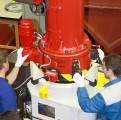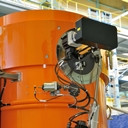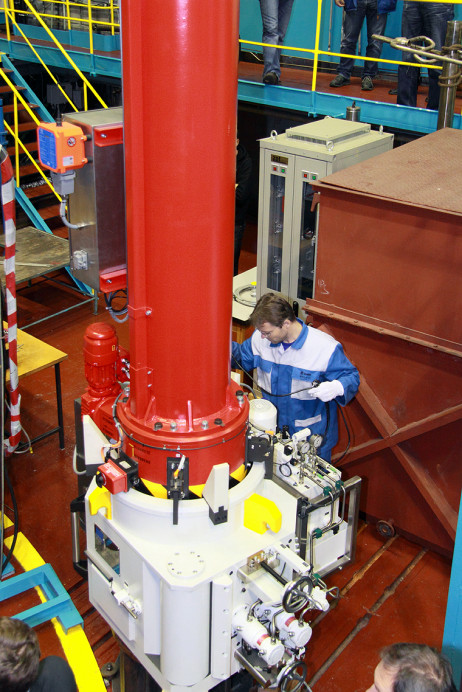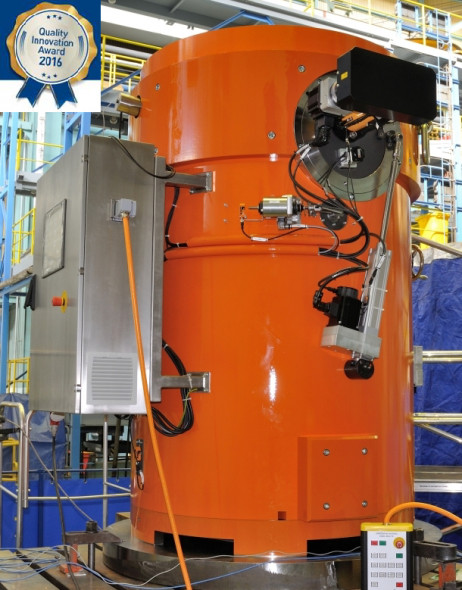Device for removal, transport and disposal of thermocouples and neutron flux sensors

After the design life has expired or in the event of a malfunction, it is necessary to remove the neutron flux sensors and thermocouples from the reactor core. ŠKODA JS has developed equipment for removing, transporting and disposing these sensors from pressure vessel of the VVER 440 and VVER 1000 reactors.
The purpose of the device is the quick and safe disposal of radioactive sensors and the protection of the operating staff against radiation.
The device for VVER 440 reactors
The device consists of two modules – transport and cutting. First, the radioactive sensor is removed from the reactor pressure vessel by means of the transport module and then transferred to the disposal site. Subsequently, the cutting module divides the sensor into small parts which are dropped into the decay storage in the reactor hall.
The sensors are removed in sequence from the block of protective tubes, which is set up in the inspection shaft. The operator first removes the upper part of the sensor, which will be disposed of manually, and separates it. The next step is to set the transport module on the prepared stand above the liquidated sensor. The transport module is installed upon the stand through a crane. The lower part of the sensor, which is still located inside the block of protective tubes, is inserted into the removing mechanism, which is located inside the transport module. This device automatically completes the process of pulling the highly active part of the sensor into the shielded part of the transport module.
Immediately after removal, the sensor is transported to the disposal site. This so-called decay storage is located on the floor of the reactor hall. Inside the transport module, the highly radioactive part of the sensor with a length of 5 m is transported to the disposal site, whereas the transport module safely shields the radiation.
At the disposal site, above the decay storage, there is a shut-off module, which is part of the equipment of the repository in the reactor hall. The cutting module is mounted on the shut-off module. After the mounting, the transport module is transferred from the sensor pull-out location to the disposal site.
After the transport module has been securely installed, the automatic process of sensor disposal is started using the remote control. The cutting module divides the sensor into 200 mm long parts, which freely fall into the decay storage. After liquidation of the sensor, the transport module is ready for another transport from the sensor pull-out location.
The device for VVER 1000 reactors
The device’s design is based on the disposal of neutron flux sensors and thermocouples sensors (hereinafter referred to as KNIZ device) by cutting. The device consists of a shielding body, which includes a mechanism for pulling the sensor, and a cutting head. Before starting the disposal, an AP-case is inserted into the device. The cutting head divides the sensor into 100 to 140 mm long parts, which then fall into so-called AP-case. Only one AP-case can be inserted into the KNIZ device.
The number of disposed sensors stored in one AP-case (i.e. for one cask transport) is up to 12 pieces. The final number of sensors stored in one AP-case is determined concerning the radiation limits and the filling of the AP-case. After filling the AP-case, the KNIŽ is moved upon the transport cask and then lowered inside it. Subsequently, the cask with the AP-case is transferred to the repository. A new AP-case is inserted into the KNIŽ and the device is ready for another disposal of sensors. The transport cask can only contain one AP-case.
The interior of the sensor disposal is monitored by two cameras. The output of the cameras is shown on the display, which is located on the switchboard.
The device is controlled by a portable controller on a five-meter-long cable. The controller contains controlling and signaling elements. More detailed information about the device status, including error messages, is displayed on the display located on the main switchboard of the device.
The KNIZ device for removal, transport and disposal of thermocouples and neutron flux sensors for VVER 1000 reactor won 1st place in the Quality Innovation Award 2016, category Business Innovations of Large Companies.
The history of our cooperation

2012 delivery of the device for VVER 440 reactor to the Mochovce NPP

2014delivery of the device for VVER 1000 reactor to the Temelín NPP










